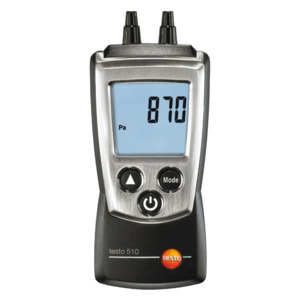
- Description
- Specifications
- Documents
- 0 - 40 in H2O pressure measurement range
- 10 selectable units of measure
- Temperature compensated pressure sensor
- Magnetic backing for hands free use
- Air flow measurement with optional pitot tube
- User adjustable air density compensation
- Protective cap for safe storage
The testo 510 is very handy, small and easy to operate. It measures differential pressure in a range of 0 to 40 in H2O. The differential pressure measurement is temperature-compensated for accurate measurement values which can be displayed in Inches of Water Column over the entire measurement range. Magnets on the back of the 510 permit hands free work. The backlit display allows the measurement values to be easily read out, even in unfavorable light conditions. The testo 510, in combination with an optional Pitot tube, measures air flow velocity. For accurate measurement values, the air density can be compensated.
Differential pressure measurement on filters
Air conditioning systems are equipped with filters which prevent dirt from the outside air entering the indoor air. These filters are to be inspected regularly to make sure they are still fully functional. To do this, the pressure is measured in front of and behind the filter. The result is the differential pressure. If it is too high, the filter is contaminated and needs changing.
The testo 510 measures differential pressures in a range of 0 - 100 hPa. The differential pressure measurement is temperature-compensated for exact readings. The readings can be displayed in pascal over the entire measuring range. Magnets on the rear of the instrument allow hands-free work.
Measurement in ventilation ducts
Observance of air flows in the ventilation duct is of utmost importance for the function of the ventilation and air conditioning system. If the air flows are smaller than intended, the removal of room loads (heating, cooling and substance loads) may not be ensured in certain circumstances.
Therefore, the most accurate recording of air flows as possible is particularly important.
In conjunction with a pitot tube, testo 510 measures the air velocity in the range of 10 to 100 m/s. Magnets on the rear of the instrument allow hands-free work.
